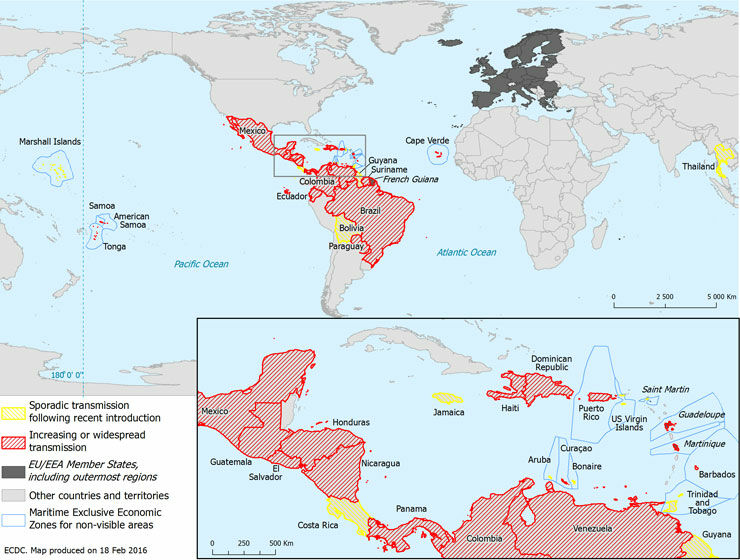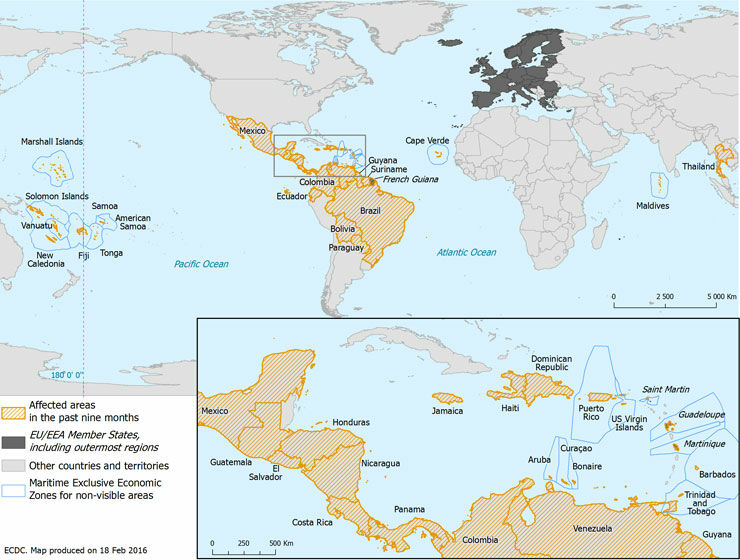Epidemiological update: Outbreaks of Zika virus and complications potentially linked to the Zika virus infection
As of 18 February 2016, autochthonous cases of Zika virus infection have been reported from 35 countries and territories worldwide in the past two months.
Since last week, four additional countries or territories have reported laboratory confirmed autochthonous transmission: Aruba, Bonaire, Marshall Islands and Trinidad and Tobago.
Aruba and Bonaire: The first confirmed cases of autochthonous Zika virus infection on the Island of Aruba and the Island of Bonaire was reported by the National Institute for Public Health and the Environment (RIVM) on 16 and 15 February.
Trinidad and Tobago: On 17 February, the Trinidad and Tobago Ministry of Health reported the first confirmed case of autochthonous Zika virus infection in the country.
Marshall Islands: According to the Pacific Public Health Surveillance Network, the first confirmed autochthonous case of Zika virus infection was reported on 14 February in a 12 week pregnant woman.
Atypical presentation of Zika virus infection
Brazil: According to PAHO, on 11 February 2016, Brazil reported on the results of a retrospective investigation of a fatal case with atypical presentation of Zika virus infection. The case is a 20-year-old female resident in Rio Grande do Norte state with no history of previous illness. She fell ill with dry cough, high fever, myalgia, fatigue and dyspnoea, on 11 April 2015. She was admitted to the ICU due to worsening condition with heavy bleeding and decompensation, and later died. Blood samples collected on 17 April 2015 were negative for dengue, and viscera fragments (liver, kidneys and lungs) of the patient were positive for Zika virus by RT-PCR. Autopsy revealed diffuse pulmonary infiltrate and bilateral pulmonary abscesses. The investigation into the cause of death is ongoing.
Detailed epidemiological situation
As of 18 February 2016, autochthonous cases of Zika virus infection have been reported from 35 countries and territories worldwide in the past two months (see Table 1 and Figure 1). Forty countries and territories have reported autochthonous cases of Zika virus infection in the past nine months (see Table 1 and Figure 2).
Several countries in the Americas, Caribbean and the Pacific continue to report an increase in autochthonous cases of Zika virus infection.
Table 1. Countries and territories with reported confirmed autochthonous cases of Zika virus infection in the past two months, as of 18 February 2016
| Country/Territory | Affected in the past 2 months | Affected in the past 9 months |
|---|---|---|
| American Samoa | Increasing or widespread transmission | Yes |
| Aruba | Sporadic transmission following recent introduction | Yes |
| Barbados | Increasing or widespread transmission | Yes |
| Bolivia | Sporadic transmission following recent introduction | Yes |
| Brazil | Increasing or widespread transmission | Yes |
| Bonaire | Sporadic transmission following recent introduction | Yes |
| Cape Verde | Increasing or widespread transmission | Yes |
| Colombia | Increasing or widespread transmission | Yes |
| Costa Rica | Sporadic transmission following recent introduction | Yes |
| Curaçao | Increasing or widespread transmission | Yes |
| Dominican Republic | Increasing or widespread transmission | Yes |
| Ecuador | Increasing or widespread transmission | Yes |
| El Salvador | Increasing or widespread transmission | Yes |
| Fiji | No | Yes |
| French Guiana | Increasing or widespread transmission | Yes |
| Guadeloupe | Increasing or widespread transmission | Yes |
| Guatemala | Increasing or widespread transmission | Yes |
| Guyana | Sporadic transmission following recent introduction | Yes |
| Haiti | Increasing or widespread transmission | Yes |
| Honduras | Increasing or widespread transmission | Yes |
| Jamaica | Sporadic transmission following recent introduction | Yes |
| Maldives | No | Yes |
| Marshall Islands | Sporadic transmission following recent introduction | Yes |
| Martinique | Increasing or widespread transmission | Yes |
| Mexico | Increasing or widespread transmission | Yes |
| New Caledonia | No | Yes |
| Nicaragua | Increasing or widespread transmission | Yes |
| Panama | Increasing or widespread transmission | Yes |
| Paraguay | Increasing or widespread transmission | Yes |
| Puerto Rico | Increasing or widespread transmission | Yes |
| Saint Martin | Sporadic transmission following recent introduction | Yes |
| Samoa | Increasing or widespread transmission | Yes |
| Solomon Islands | No | Yes |
| Suriname | Increasing or widespread transmission | Yes |
| Thailand | Sporadic transmission following recent introduction | Yes |
| Tonga | Increasing or widespread transmission | Yes |
| Trinidad and Tobago | Sporadic transmission following recent introduction | Yes |
| Vanuatu | No | Yes |
| Venezuela | Increasing or widespread transmission | Yes |
| US Virgin Islands | Sporadic transmission following recent introduction | Yes |
EU/EEA and EU Outermost Regions and Territories
As of 18 February, no autochthonous Zika virus transmission has been reported in continental EU. ECDC is collecting data regarding imported cases through the media and official government communication lines. As of 18 February 2016, ECDC has recorded 113 imported cases in 14 EU/EEA countries: Austria (1), Denmark (1), Finland (2), France (18), Germany (20), Ireland (3), Italy (5), Malta (1), Netherlands (24), Portugal (6), Spain (23), Sweden (1), Slovenia (1) and the UK (7).
Thirty EU/EEA countries have issued travel advice for people travelling to Zika-affected areas. Of these, 26 have advised pregnant women to consider postponing travel to countries affected by the Zika epidemic.
Several Outermost EU regions continue to report autochthonous transmission.
Martinique: From December 2015 to 17 February 2016, 6 050 suspected cases have been reported. This is an increase by 2 130 cases during the past two weeks. Due to the carnival season, not all general practices have been reporting during the past two weeks, thus the epidemic trend cannot be determined.
French Guiana: From December 2015 to 17 February 2016, 889 suspected and laboratory confirmed cases have been reported. This is an increase by 360 cases during the past two weeks.
Guadeloupe: As of 17 February 2016, there have been 246 suspected and laboratory confirmed cases have been reported. This is an increase by 134 cases since the last two weeks.
St Martin: Seven laboratory confirmed cases have been reported as of 17 February, an increase by 6 cases since the last report on 4 February 2016.
Aruba: The first four confirmed cases of autochthonous Zika virus infection on the Island of Aruba was reported by the National Institute for Public Health and the Environment (RIVM) on 16 February. The cases include three local residents and a Dutch traveller visiting Aruba. In addition, seven imported cases from Zika-affected areas have been identified.
Bonaire: The first confirmed case of autochthonous Zika virus infection on the Island of Bonaire was reported by the National Institute for Public Health and the Environment (RIVM) on 15 February.
Curaçao: On 15 February 2016, media quoting the Ministry of Health reported 35 cases of Zika virus infection in the country.
Figure 1. Countries and territories with reported confirmed autochthonous cases of Zika virus infection in the past two months, as of 18 February 2016

Note: the map does not indicate the extent of the autochthonous transmission in the countries.
Figure 2. Countries and territories with reported confirmed autochthonous cases of Zika virus infection in the past nine months, as of 18 February 2016

Note: the map does not indicate the extent of the autochthonous transmission in the countries.
Update on the observed increase of congenital microcephaly and other central nervous system symptoms
According to the WHO situation report on Zika and potential complications published on 12 February 2016, six countries have reported an increase in the incidence of cases of microcephaly (Brazil) and Guillain-Barré syndrome (Brazil, French Polynesia, El Salvador, Venezuela, Colombia and Suriname) in conjunction with the Zika virus outbreak.
Brazil: According to the Ministry of Health, there have been 5 280 cases of microcephaly notified to date in Brazil. Of these, 3 174 cases (60.1%) were reported in 2015 and 2 106 (39.9%) in 2016. As of 13 February 2016, 508 cases of microcephaly have been confirmed to have microcephaly and/or other central nervous system findings suggestive of congenital infection. According to a previous update from the Ministry of Health in Brazil, as of 6 February, of the 462 cases confirmed to have microcephaly cases, 41 (8.9%) had a laboratory confirmed Zika virus infection. Across the country, 3 935 suspected cases of microcephaly remain under investigation.
There have been 108 intrauterine or neonatal deaths reported among children notified to have microcephaly and/or central nervous system malformations. Of these, 27 cases were investigated and confirmed to have microcephaly and/or central nervous system malformations. Seventy cases are still under investigation and 11 cases have been discarded.
Additional information may be found in the latest ECDC Risk Assessment.




